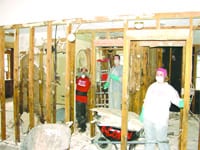Emergency Room Physician Offers Safe Snow-removal Tips
WARE — A mild January for snowfall came to a quick end as winter storm Juno left several inches, and in some areas several feet, of snow. “It seems that winter is finally arriving, and upcoming weather predictions include more snow and a mixed bag of conditions,” said Dr Richard Gerstein, chair of Emergency Medicine at Baystate Mary Lane Hospital. “This winter weather brings cold temperatures, snow, and a list of injuries that are common with the season.”
According to a study in the American Journal of Emergency Medicine, U.S. hospitals treat on average about 11,500 injuries and medical emergencies a year related to shoveling snow. The activity places demands on the cardiovascular system and can raise heart rates above recommended upper limits for unfit people. Two-thirds of shoveling injuries occurred in men, and 15{06cf2b9696b159f874511d23dbc893eb1ac83014175ed30550cfff22781411e5} of injuries were in children under 18 years old.
To prevent those injuries, Gerstein offered these snow-shoveling safety tips:
• If you are inactive and have a history of heart trouble, talk to your doctor before you take on the task of shoveling snow.
• Avoid caffeine or nicotine before beginning. These are stimulants, which may increase your heart rate and cause your blood vessels to constrict. This places extra stress on the heart.
• Drink plenty of water. Dehydration is just as big an issue in cold winter months as it is in the summer.
• Be sure your muscles are warm before you start shoveling. Cold, tight muscles are more likely to sprain or strain than warm, relaxed muscles. Warm up your muscles before shoveling by walking for a few minutes or marching in place. Stretch the muscles in your arms and legs, because warm muscles will work more efficiently and be less likely to be injured.
• Pick the right shovel for you. A smaller blade will require you to lift less snow, putting less strain on your body. Begin shoveling slowly to avoid placing a sudden demand on your heart. Pace yourself and take breaks as needed.
• Protect your back from injury by lifting correctly. Stand with your feet about hip width for balance and keep the shovel close to your body. Bend from the knees (not the back) and tighten your stomach muscles as you lift the snow. Avoid twisting movements.
“If you are not shoveling but using a snowblower — a great piece of machinery — if it’s not used correctly, you can strain or injure your back,” Gerstein added. “Snowblowers are designed to remove snow at a particular rate of speed. Do not push or force the equipment to go faster; let it do the work for you. If the snowblower clogs with ice, the blade may stop turning, but the engine may not shut off.”
In addition, he noted, “reaching inside the blades can cause damage to hands and fingers when the blades start turning. Also, stay away from the engine, which can become very hot.


Comments are closed.